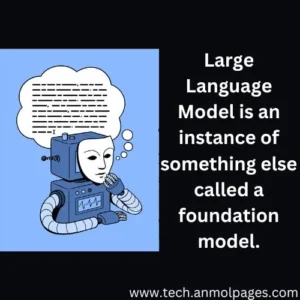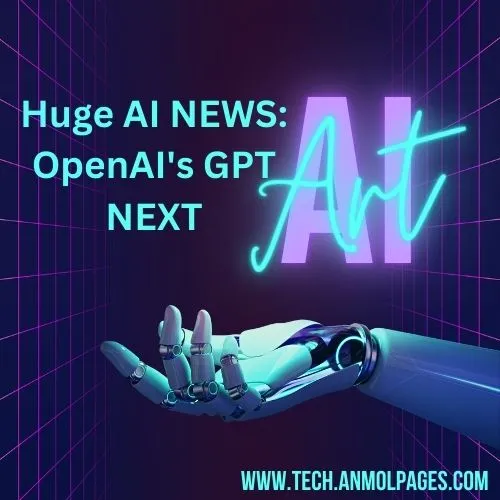Huge AI NEWS: OpenAI’s GPT NEXT:-Welcome back to the Tech AnmolPages. In today’s Topic, we’re going to be taking a look at some of the most important AI stories this week. Now, I got to be honest, the majority of these stories came pretty much is actually a ton of information that pertains to the future of foundation models for the AI space.
Reid Hoffman on the future of GPT models, including GPT-6
So let’s actually take a look because there’s so much to be condensed, so let’s not waste any more time. Reid Hoffman actually spoke about the future models in terms of GPT-6, and I know you might be thinking, why on Earth is someone speaking about the next iteration of models after GPT-5? Well, I think it’s because, those models are trademarked, and it’s quite likely that we will get those models in the future.
Discussion on scaling and potential limitations with future AI models | Huge AI NEWS: OpenAI’s GPT NEXT
Number two, it’s been widely speculated that GPT-6 and those foundation models are going to be the ones that are a magnitude of scale even higher than GPT-5 or GPT Next and that those models will contain the agenta capabilities. But take a listen because this is rather fascinating pure model competition. The question is, when do we start seeing a return to scale, and my guess is, kind of the GPT landmarks, each order of magnitude, my guess is the soonest will be GPT-6, and it might even be after that.

The role of smaller models and startup opportunities in AI
That’s part of the bet that OpenAI, Anthropic, and the hyperscalers are all making, that return to scale. That has a lot of downstream effects because even if you say we can train smaller models to do effective things, part of what’s going to be really instrumental for training those smaller models is the larger models. Even if there’s a bunch of smaller models that are specifically capturing other kinds of market opportunities,
which is part of what I’ve been doing and investing in AI since 2014-2015, there’s going to be a set of those things that are a whole bunch of startup opportunities. So I think the A vs. B is a good dramatic framing, but it’s really on which specific opportunities because there are going to be wins and opportunities across them.
Insights from a 100-page report on AI model scaling up to 2030
So while, yes, Reid Hoffman is saying that there’s going to be two orders of magnitude of improvement from scaling AI models, this is something that I completely agree with. This isn’t a statement that is too far-fetched in terms of what a lot of the research surrounding AI currently says. Despite many different critics having their opinions on how far scale is going to get us, I think there is, of course, quite a lot more room in terms of scale. If you didn’t recently watch the video I made, it dives into a 100-page report from Epoch AI, where they dive into the details of whether scaling can continue into 2030.
OpenAI’s plans for GPT Next and the strawberry and Orion models | Huge AI NEWS: OpenAI’s GPT NEXT
They’re basically saying that by 2030, it’s going to be very possible to train models that exceed GPT-4 in scale to the same degree that GPT-4 exceeds GPT-2 in scale. And if you aren’t familiar with what that means, basically GPT-4 was 10,000 times bigger than GPT-2, and it’s quite likely that two more Iterations of models like GPT-6 or the models that follow are quite likely going to be 10,000 times bigger than our current models. By 2030,
You May Also Like:-How Large Language Models Work | Understanding GPT | The Future of Business Through Large Language Models

whichever training runs are taking place and whichever models are being developed are allegedly going to be, according to this extensive report, 10,000 times larger. I do think it’s quite accurate that, at that point, we may see diminishing returns. However, the key point in that interview clip is that Reid Hoffman didn’t suggest diminishing returns overall; he specifically mentioned diminishing returns from scaling the models. This is an important nuance that some people miss.
What he’s saying is that while scaling the size of AI models might not yield the same returns as it used to, that doesn’t mean we’ll see diminishing returns in AI as a whole. It just means that focusing solely on increasing model size may no longer be as effective. In terms of probably the most interesting piece of information in this video, though there’s a lot to discuss, we did get a very small but intriguing insight into the future of AI development.
OpenAI’s roadmap and speculation on GPT Next’s capabilities
New releases from OpenAI and what to expect
I’ve shown you this chart before on Twitter, and OpenAI has presented it in several different settings. If you’re wondering whether this chart is fake, it’s not—it’s from the CEO of OpenAI in Japan. The chart indicates that we’ll likely see the release of GPT Next later this year.
There’s speculation that GPT Next could be the “Strawberry” model, which has been trained on data from “Orion.” We know that OpenAI is working on two models: the Strawberry model, which is a smaller and distilled version, and the Orion model, which appears to be their new frontier model with advanced AI capabilities.
One of the most intriguing aspects of this data is the reference to “100x” seen on the chart. This signifies the projected rate of progression and the expected improvements in how effective these AI models will become. If OpenAI is conducting demos like this, it’s a sign that they’re showcasing how quickly the capabilities of these models are advancing.
Google’s AI advancements with Gemini 2.0 and video models
I’ve seen some comments online suggesting that all of this is just hype, but I would argue that we should wait until we see an actual demo. That’s when we’ll know whether OpenAI is all hype or if they can live up to the high standards they’ve set. Against what most people expect, I believe OpenAI is going to exceed everyone’s expectations. I’m not saying this because I run an AI channel,
but if we consider the sheer amount of time they’ve had compared to their competitors, how much they’re investing in their lead researchers, and the talent at OpenAI, it would be foolish to think they’re falling behind just because they haven’t released anything yet. Of course, this is debatable, and I could be completely wrong when these models get released or announced later in 2024.
One of the key details stated is that the “100 times” improvement doesn’t refer to scaling computing resources but rather to effective orders of magnitude in performance. This doesn’t mean just throwing more hardware at the problem but includes advancements in architecture and learning efficiency. The CEO has said that the AI model, GPT Next, will evolve nearly 100 times based on past performance.
Unlike traditional software, AI technology grows exponentially, which is why I think it’s going to exceed expectations. The increase likely refers to the effective computational power, not just raw compute resources, along with significant improvements in architecture and learning efficiency.
I find this fascinating because it gives us a glimpse of the future of AI. While it might be hard to believe right now, especially when looking at these graphs that are difficult to grasp fully, the demos we’ve seen, like Sora, SearchGPT, and the secret capabilities of GPT-4.0, suggest that there’s more happening behind the scenes. If the next generation of models truly offers such a drastic improvement in intelligence,
it could revolutionize the field. I’m curious to see how GPT Next (or GPT-5, if that’s what it’s called) will be applied because we saw how GPT-3.5 was great for casual conversations and entertainment, but the next model could take things much further.
Discussing the future applications and impacts of more advanced AI models
With GPT-4, we saw significant advancements, such as the ability to use tools, perform complex coding tasks, and accomplish a wide range of impressive capabilities. If GPT Next lives up to expectations and proves to be nearly 100 times more effective, with reasoning abilities almost doubled, it will open doors to unprecedented applications.
As the reasoning capacity of the model increases, alongside its reliability—particularly in reducing hallucinations and improving response accuracy—it’s intriguing to think about the industries that will be impacted. Some industries may benefit dramatically, especially since we’ve already witnessed the improvements that even a marginally enhanced model, like Claude, brought over GPT-4. For instance, in coding,
where GPT Next’s potential impact could be groundbreaking, a simple prompt could lead to more sophisticated software development. This moment could be pivotal for those in the AI space, with attention squarely focused on how the new models will change the landscape.
Moreover, OpenAI isn’t the only player in the race to develop future foundational models. Google’s lead product manager for Google AI Studio has been tweeting about upcoming innovations, such as Google Search grounding, Gemini 2.0, and AI agents. These announcements reflect Google’s steady push to release more AI features to the public. For example, the release of Imagen 2 or 3 in the EU allows users to create high-quality images.
Although the feature may not seem groundbreaking at first, the model’s prompt adherence and output quality have shown impressive improvements. With Google’s ramped-up efforts, the next six months are set to be an exciting and competitive period, as both OpenAI and Google race to captivate users with new AI capabilities. The competition between AI giants is sure to heat up, and consumers will be treated to a wide array of innovative tools and services.
